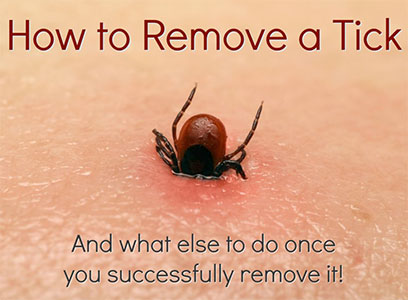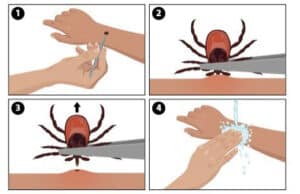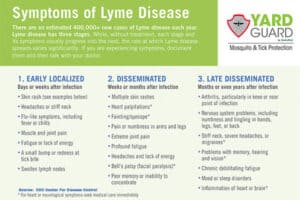You probably already know that ticks can cause you to contract Lyme’s disease. But you’d be surprised how many other diseases ticks can carry and infect you with. You’re probably here because you’re concerned about how to remove ticks. Although they are hard to spot, it’s crucial to remove them instantly if you see a tick on yourself or a loved one.
There’s a lot that most people don’t know about the danger of ticks. In fact, some diseases they carry can even be life-threatening to the elderly. The risk of infection increases after the first 24-48 hours. That’s why it’s best to take the proper measures and remove the tick the second you spot it.
What Are Ticks?
Ticks are small, brown insects with flat, oval bodies which swell up when they eat. They’re tiny in size, making them hard to detect; even adult ticks are only the size of an apple seed. They have eight legs and are closely related to spiders.
Ticks feed on the blood of animals and humans and can transmit various diseases to their prey. They can stay attached to your skin for ten days, after which the engorged tick typically falls off your skin.
A fully engorged adult tick can even get as big as a marble. These arachnids can bite you any time of the year, but they’re most active in the summer, from April through September.
They live in wooded areas where there are plants and shrubbery. This type of location makes it easier for them to latch on to animals or humans.
You may even find them in your backyard, where there are overgrown patches of grass or hidden in trees. If ticks somehow latch on to your pet, it becomes easier to make their way into your home.
How To Remove Ticks
Here’s all you need to know about the dos and don’ts of tick removal.
What Not To Do
The first and most important thing to remember while removing a tick is avoiding any unique hack you may have seen online. Smothering the tick with Vaseline, nail polish, or rubbing alcohol will not help.
We also advise against trying to burn the tick while it’s still attached to you, as that can cause the tick to release its infected fluid onto your skin. The simplest and safest way to remove a tick is with a pair of pointy tweezers.
Use The Right Tweezers To Remove Ticks
You can accidentally detach the tick’s head from its body with square-tipped tweezers. It would be best to use fine-tipped tweezers. Other than that, you’ll only need some rubbing alcohol.
How to Remove Ticks: What To Do
Here’s a dermatologist-recommended step-by-step method to removing ticks.
- First, sterilize the tweezers’ tips with rubbing alcohol. Use the tweezers to grab the tick as close as possible to its head and your skin. If you grasp the tick by its swollen belly, it can push the infected fluid into your body when applying pressure.
- Next, pull away from your skin with steady and even pressure. If you attempt to crush, squeeze, or twist the tick with the tweezers, it may worsen the situation. It can result in the head still being attached to your body while the rest is gone.
- In that case, try your best to pull out the rest of the tick. If that proves impossible, consult a certified dermatologist as soon as possible.
- Save the tick for your trip to the doctor.
- A test will help you determine which tick-related disease you’ve contracted. You can, however, also store the tick in an airtight container. That way, you’ll be able to send it for testing if you’re experiencing symptoms after removing the tick.
- Should you choose to dispose of the tick, it can seem tricky. Either flush it down the toilet or wrap it in tape before throwing it away to ensure it doesn’t find its way back. Submerging it in rubbing alcohol is another way to dispose of a tick.
- Last but not least, you should clean the bite area with soap and water. It’s also best to cover it in petroleum jelly and put a band-aid over it to avoid skin infection.
When To Contact Your Doctor
You can contact your doctor to ask about how to remove any ticks or if you’re experiencing symptoms. Even if the symptoms appear weeks after removing the tick, be sure to contact your doctor. The symptoms of Lyme Disease can include drowsiness, aching muscles, or a headache. If you’re not experiencing symptoms, we do recommend that you see your doctor after a tick bite.
It would be best if you started treating Lyme’s disease before symptoms show.
What Diseases Do They Spread?
After most people figure out how to remove ticks, they begin to research the effects of ticks. Ticks infect you by passing on viruses, bacteria, and parasites into your skin. Parasites have the sole purpose of feeding off you, so you do not want them on your body.
Contrary to popular belief, Lyme’s disease isn’t the only way a tick can infect you. Unfortunately, the list of tick-related diseases is long and problematic.
Anaplasmosis
You can get Anaplasmosis from the black-legged tick that resides commonly in the Northeast and Upper Midwest. Symptoms of this disease are typical, including chills, fever, and muscle aches, but you can treat it simply with antibiotics.
You may get this disease from the western black-legged tick on the West Coast.
Babesiosis
Babesiosis is another disease with which the backlogged tick can infect you in the Northeast and Upper Midwest. The difference with this disease is that its parasites attack your red blood cells. This disease can be life-threatening for the elderly.
If you have your spleen removed or have a weak immune system, this disease can also affect you worse than others.
Borrelia Miyamoto
Backlogged ticks are the reason behind many different diseases, one of which is Borrelia Miyamoto. This disease can cause flu-like symptoms like headache, fever, chills, and muscle aches.
Other than that, you may also experience joint pain. You can treat Borrelia Miyamoto with antibiotics.
Colorado Tick Fever
Colorado, Utah, Montana and Wyoming are where you would most commonly find the Rocky Mountain wood tick. This tick causes Colorado Tick Fever, which has symptoms such as irregular fever, lethargy, and headache.
In rare cases, you may even experience a maculopapular or petechial rash. Since this is a biphasic disease, the symptoms may go away only to return in a few days.
Ehrlichiosis
In South-Central and Eastern US, the lone star tick can cause Ehrlichiosis disease. This illness can cause symptoms like muscle pain, chills, fever, rashes, nausea and even an altered mental state.
You can treat this tick-related disease with antibiotics.
Lyme Disease
Lyme Disease is the most common infection you can get from ticks. Blacklegged ticks in the Upper Midwest and Northeast are the parasite behind this disease. Its most telltale symptom is the Erythema migrans, a red ring-like or homogeneous expanding rash.
Other than that, you may also experience flu-like symptoms and lymphadenopathy. You must treat Lyme disease early on or it can result in problems with your brain and heart.
Its neurological manifestations include Bell’s palsy, meningitis, and subtle cognitive difficulties. Lyme disease can also cause cardiac issues such as conduction abnormalities and myocarditis. Other than that, it may result in joint pain that doesn’t go away. To find out what ticks carry Lyme disease check out our latest article.
Powassan Virus
The Powassan Virus isn’t a common tick-related disease but caused by the black-legged or groundhog tick in the US and Canada. The incubation period is about one to four weeks, and the symptoms include fever, headache, and vomiting.
Later, these symptoms can evolve into altered mental status, paresis, aphasia, seizures or even cranial palsies.
Red Meat Allergy
A lone star tick bite can even result in the development of a red meat allergy. An allergic reaction to red meat can result in diarrhea, runny nose, sneezing, headaches, low blood pressure and hives.
This allergic reaction can occur four to eight hours after consuming red meat.
Rocky Mountain Spotted Fever
The American dog tick causes the Rocky Mountain Spotted Fever. These are in the Eastern, Central and Western US. The worst part about this disease is that it can even turn fatal if not treated within the first five days of visible symptoms.
Early symptoms of RMSF include fever, headache, malaise, edema and nausea. Late symptoms can get as extreme as necrosis, respiratory compromise, coma, altered mental status and even multi-organ system damage.
How To Avoid Tick Bites
Here are a few measures you can take to avoid tick bites in the future.
Walk-In The Center Of Trails
When you’re on a hike or run in the woods, make sure to walk in the center of trails. Straying towards bushier or woodier areas with tall grass can make it much easier for a tick to latch on to you.
Cover Your Skin
You may need to walk through heavily wooded areas for camping or other activities. In that case, you should keep your skin covered with long pants and long sleeves. To prevent ticks from crawling inside your clothes, wear your socks over your pants and tuck in your shirt.
Ticks will also be much easier to spot if you’re wearing light-colored clothes.
Use Insect Repellent
Ensure the insect repellent you choose has at least 20-30% DEET. We highly recommend always having insect repellent applied before hiking or outdoors where you may have exposure to ticks. If you have kids, always remember to use it on them before they go out, avoiding their hands, eyes, and mouth.
Examine Your Skin
After spending time in the woods or bushy areas, make sure to examine your skin thoroughly. It’s best to take a shower as soon as you get home to do a full-body check with ease.
Hire A Tick Treatment Specialist
You can take preventive measures to avoid tick bites on your body, but how do you ensure no ticks get into your yard? Where do ticks live in your yard? How do they get into your house? They can crawl in by hitching a ride on your pets or person after being outside in your yard. This uncertainty is why most homeowners are moving to professional tick exterminators. An experienced company will take the time to inspect and treat all the conducive areas around your yard and home. They will do this regularly throughout the warm months.
How to Remove Ticks FAQs
Here are the answers to the most frequently asked questions about ticks.
How long does a tick have to be attached to transmit disease?
A tick must feed off human blood before it transmits any disease. This feeding takes around 36 to 48 hours before transmitted diseases like RMSF, Powassan virus, etc., occur.
Some ticks, however, can even stay attached to your body for ten days. After this period, they’ll be engorged with blood and detach from your body naturally.
Where on the body do ticks commonly attach themselves?
Ticks most commonly attach to warm and moist areas, whether on your body, your pets’ or in the wild. While searching for ticks, look in these places first and foremost:
- Hair
- Groin
- Armpits
- Bellybutton
- Backs of knees
- Around the waist
- Inside and around the ears
How long can ticks live in a house without a host?
You’d be surprised at how long ticks can live in a house without a host. Typically, they need to find a host within 30 days, but some ticks can even go as long as 117 days without one.
In the case of Rocky Mountain ticks, they can molt into nymphs and even survive for 300 days without feeding. This period increases to 600 days once they become adults.
Prevention is key to handling ticks in and around your home. Use repellents, treat your pets with flea tick medication, and hire a professional tick exterminator. Please don’t wait and find out like so many New York homeowners who wished they had called EnviroPest Tick Extermination earlier to sign up for our Enviro 180 Yard Guard Tick Pest Control Program.





